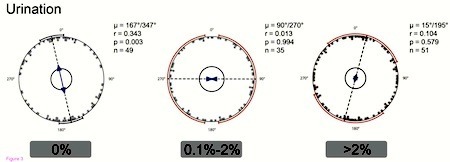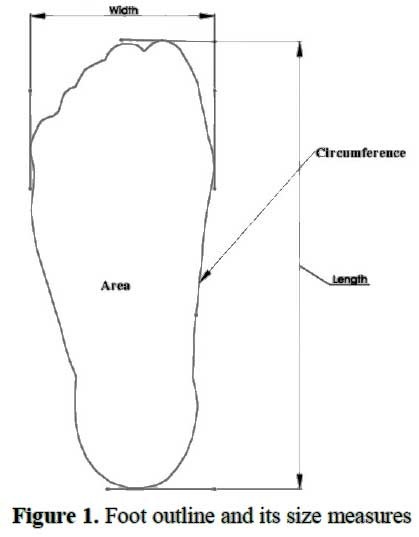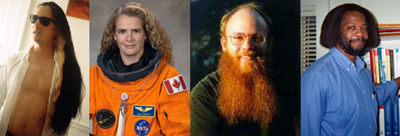Marc Abrahams's Blog, page 435
December 31, 2013
Juan-Carlos Perez-Cortes joins Luxuriant Flowing Hair Club (LFHCfS)
Juan-Carlos Perez-Cortes has joined the Luxuriant Flowing Hair Club for Scientists (LFHCfS). He says:
I’m a computer scientist working in the field of Pattern Recognition and Machine Learning. I have been pursuing a billion-dolar project to design an algorithm that identifies a luxuriant flowing hair from a regular hair in an image taken at a distance of more than 10 miles, but so far no agency has recognized the important advancement it would be for humanity… I’ll keep trying.
Juan-Carlos Perez-Cortes, PhD., LFHCfS
Scientific Director / Director Cientifico,
Instituto Tecnologico de Informatica (ITI)
Ciudad Politecnica de la Innovacion (Edif. 8G)
Universidad Politecnica de Valencia
Valencia, Spain


A sort of cow, and some sorts of cockroaches
Here’s a year-end tiny collection comprising a cow and lots of cockroaches.
The cow is mechanical, caught here on video (Thanks to Rachel Ehrenberg for bringing it to our attention):
The University of California supplies this description:
Cow: the digestive system’s complex mysteries:
Nova Jiang is an artist and UCLA alumna who makes work that connects different fields and encourages audience participation. One of her recent projects was done for the Pittsburgh Children’s Museum. ‘Cow’ is an interactive mechanical wood sculpture that kids can place a ball in it’s mouth and watch it travel a simplified version of the digestive cycle.
The cockroach is mechanical, too, but only in the sense that any living animal is a mechanism and any dead one a broken or de-energized mechanism. Rockefeller University aims to, in its words, DNA barcode the American cockroach (Periplaneta americana). Savor their goal and their thoughtful approach, if you will, by familiarizing yourself with The National Cockroach Project:

December 30, 2013
Dog excretion accretion as indicator of Earth’s magnetic field
This study gathered and assessed evidence of the possible effects of the Earth’s magnetic field on the tangible output of dogs:
“Dogs are sensitive to small variations of the Earth’s magnetic field,” Vlastimil Hart [pictured here], Petra Nováková, Erich Pascal Malkemper, Sabine Begall, Vladimír Hanzal, Milo¿ Je¿ek, Tomá¿ Ku¿ta, Veronika N¿mcová, Jana Adámková, Kate¿ina Benediktová, Jaroslav ¿ervený and Hynek Burda, Frontiers in Zoology, 2013, 10:80, 27 December 27, 2013. (Thanks to Sarah Zielinski for bringing this to our attention.) The authors, at Czech University of Life Sciences and the University of Duisburg-Essen, report:
“We measured the direction of the body axis in 70 dogs of 37 breeds during defecation (1,893 observations) and urination (5,582 observations) over a two-year period. After complete sampling, we sorted the data according to the geomagnetic conditions prevailing during the respective sampling periods. Relative declination and intensity changes of the MF during the respective dog walks were calculated from daily magnetograms. Directional preferences of dogs under different MF conditions were analyzed and tested by means of circular statistics.”
Here are details from the study:




Foot size and balancing – a link?
 Doctoral student Hai Qiu and professor Shuping Xiong of the Ergonomics and Applied Biomechanics Lab at the Ulsan National Institute of Science and Technology (UNIST), Korea, have recently been investigating ‘The Influence of Foot Sizes on Human Balance’
Doctoral student Hai Qiu and professor Shuping Xiong of the Ergonomics and Applied Biomechanics Lab at the Ulsan National Institute of Science and Technology (UNIST), Korea, have recently been investigating ‘The Influence of Foot Sizes on Human Balance’
“This study investigated the relationship between foot size and human balance performance. The balance performances of 30 female subjects (15 young, 15 elderly) were assessed by a force platform system.”
The experimental study found that participants with larger feet were not so prone to swaying than those whose feet were less generously proportioned.
“In general, the bigger the foot size, the lower mean sway velocity and the bigger the normalized foot size, the higher balance strategy score (more ankle strategy), especially for the young group.“
The paper is published in : Proceedings of the Human Factors and Ergonomics Society Annual Meeting, September 2013 vol. 57 no. 1 pp. 920-924

December 29, 2013
New Internet search fails to turn up evidence of time travelers
Internet search engines are not yet reliable enough to find evidence of time travelers — if that information exists and if it’s findable. That’s what this new study suggests:
“Searching the Internet for evidence of time travelers,” Robert J. Nemiroff [pictured above], Teresa Wilson [pictured below], arXiv:1312.7128, December 26, 2013. The authors, at Michigan Tech, write:
“Time travel has captured the public imagination for much of the past century, but little has been done to actually search for time travelers. Although less well known than popular fiction, experiments designed to discover human time travelers have been conducted. In May of 2005, then graduate student A. Dorai at MIT publicised and held a convention for time travelers. No one claiming to come from the future showed up [17]. S. Hawking did a similar experiment in July of 2012, holding a personal party for time travelers, but sending out the invitations only after the party.
No one claiming to be a time traveler showed up. In this work, we report on a series of searches for digital signatures that time travelers potentially left on the Internet. Specifically, we search for content that should not have been known at the time it was posted. Such information is here referred to as “prescient”. To the best of our knowledge, no similar search has ever been published previously….
“Given practical verifiability concerns, only time travelers from the future were investigated. No time travelers were discovered. Although these negative results do not disprove time travel, given the great reach of the Internet, this search is perhaps the most comprehensive to date.”
(Thanks to @Markawriter for bringing this to our attention.)
Here’s video of Stephen Hawking discussing his Internet-search-engineless approach to the question:
BONUS (unrelated): “Nearly a year and four months have elapsed since I released my series of papers on inter-universal Teichmuller theory.” (HT Cliff Pickover)
BONUS (related to the aforementioned unrelated item: the good old days): Inter-universal Teichmuller theory, as things stood in 2011

Makeover for the Luxuriant Flowing Hair Club for Scientists (LFHCfS) site
Fashion news! We’re giving a makeover to the website for the Luxuriant Flowing Hair Club for Scientists™ (LFHCfS) and its conjoined clubs, The Luxuriant Former Hair Club for Scientists™ and The Luxuriant Facial Hair Club for Scientists™.

Isaac Newton (1642-1727). Historical Honorary Member, LFHCfS
LFHCfS began in 2001 with its first member (psychologist Steven Pinker),
and became so popular that it quickly grew beyond the bounds of that original little chunk of website. History ensued, highlighted by the founding of the “Former” and “Facial” clubs in 2010. New members now appear first in the Improbable Blog’s LFHCfS category, and are later gathered into Member Galleries based on the year they were inducted. To see some technical notes about the makeover, scroll down.
LFHCfS is welcoming new members!
Do you know a scientist with the necessary qualifications? Suggest that they join the LFHCfS!

LFHCfS members Slater, Payette, Norvin, & Gates, et al., are eager to welcome new members!
Tech notes about the the makeover to the LFHCfS web site
The makeover aims to do several things:
Create all these member galleries (here are 2013 and 2012)
Expound on the club history and the perks of membership
Explain how the club has expanded to become three (3) conjoined clubs, each with the same LFHCfS acronym
Make it easier to read the site (it was all packed a-jumble, as in an old warehouse)
Add links to hair-related resources
Re-vamp the Historical Honorary Members page
Make it easier for the early members to link to their own listing (read: brag) by giving each listing a unique HTML anchor tag – so far, we’ve revised the old entries up to 2005.
BONUS (for members of a certain bent): Here’s a technical technical note about the member galleries: each member’s unique anchor tag will be their last name-hyphen-first initial. This means that David Wilson can link to his listing by finding himself in Gallery 6, and then adding #wilson-d to the end of that URL. For example: http://www.improbable.com/projects/hair/hair-club006.html#wilson-d

Sam Lloyd’s Get-Off-the-Earth Puzzle
Jill Britton writes about one of the most influential of the influential puzzle-maker Sam Lloyd‘s puzzles:
One of the most popular puzzles ever created was the Get Off the Earth puzzle, invented by American’s premier puzzlist, Sam Loyd, in 1898. Over ten million copies of the puzzle were produced…. The puzzle shows a number of Chinese warriors around the rim of a circular piece of cardboard fastened at the center to a larger piece of cardboard so it can be turned. Part of each warrior is inside the circle and part is outside. When the disk is rotated from its initial position to its second position, one warrior disappears! The challenge is to explain how this “disappearing act” works….
UNRELATED BONUS, TANGENTIALLY INVOLVING THE SUN:

December 28, 2013
Thesis topics, each summarized in one sentence
Students describe their thesis topic, in one sentence. The LoL My Thesis web site presents lots of these single-sentence summaries. Here are a few [each with the person's field-of-study and institution]:
This is a weird star cluster and we absolutely have no idea how it formed – sorry. [Astrophysics, Whitman College]
A kiwi egg, despite appearances, is exactly the size you would expect given it only lays one. [Zoology, Duke]
14th and 19th century Londoners reacted differently to disease because of the shift in dominant cultural paradigms – or, you know, any number of other things. [Religious Studies, Elon University]
I can guess your age from Facebook even you hide it. [Computer Science, Peking University]
Trust your gut, except when your gut is being an asshole, which can be really hard to tell, but do your best. [Philosophy, Western University]
Poetry is, and should be, like noodles. [Comparative Literature, Columbia College Chicago]
(Thanks to investigator Vaughn Tan, whose research is on so many topics that it defies summary, for bringing this to our attention.)

Human exhaust-pipe found-object registry (2013, in one country)
Thank you to the disturbingly many people who alerted us to this article in Deadspin:
What Did We Get Stuck In Our Rectums This Year?
As in past years, the U.S. Consumer Product Safety Commission has created a searchable database of emergency room visits around the country. And as in past years, we have trolled the data for the finest examples of insertions showcasing extraordinarily bad luck and/or ingenuity.…
BONUS: The 1995 Ig Nobel Prize in literature was awarded to David B. Busch and James R. Starling, of Madison Wisconsin, for their deeply penetrating research report, “Rectal foreign bodies: Case Reports and a Comprehensive Review of the World’s Literature” [published in the journal Surgery, September 1986, pp. 512-519]. The citations include reports of, among other items: seven light bulbs; a knife sharpener; two flashlights; a wire spring; a snuff box; an oil can with potato stopper; eleven different forms of fruits, vegetables and other foodstuffs; a jeweler’s saw; a frozen pig’s tail; a tin cup; a beer glass; and one patient’s remarkable ensemble collection consisting of spectacles, a suitcase key, a tobacco pouch and a magazine. Here is a portion of one chart from Busch and Starling’s prize-winning study:

Worrying about what other people might think of you, if you haven’t worried about what other people might think about you
A new study suggests that Facebook users who haven’t worried about what other people might think about them might worry about what other people think about them. The study also suggests that this is more true of some people than of others. (Thanks to investigator Erwin Kompanje for bringing this to our attention.) The study is:
“Awkward Encounters of an “Other” Kind: Collective Self-Presentation and Face Threat on Facebook,” Eden Litt, Erin Spottswood, Jeremy Birnholtz [pictured here], Jeff Hancock, Madeline E. Smith, and Lindsay Reynolds, to appear in Proceedings of the 2014 ACM Conference on Computer-Supported Cooperative Work, Baltimore, MD, February 15-19. The authors, at Northwestern University, explain:
“The information users share about one another can have significant impacts on impression formation, and at times this other-generated content may be face threatening, or challenging to one’s desired self-presentation….
“THEORETICAL IMPLICATIONS: While we tend to emphasize the ‘self’ when thinking about and researching self-presentation, our study highlights that others can influence and pose challenges to our self-presentation goals on social network sites like Facebook. While others influence self-presentation and threaten face in a range of situations, our results showcase unique attributes of social network sites that can make this particularly challenging. “
BONUS: The HealthDay news site reports on this study, in an efficiently space-filling manner: “Survey found those intent on putting best face forward were likelier to feel bad about online miscues”
BONUS: A Beatles song, “I, me, mine”:

Marc Abrahams's Blog
- Marc Abrahams's profile
- 14 followers






